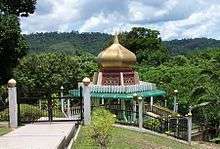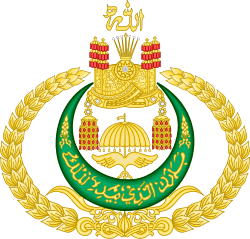Sharif Ali
Sharīf ‘Alī ibn ‘Ajlān ibn Rumaithah ibn Muḥammad (Arabic: الـشـريـف عـلي ابـن عـجـلان ابـن رمـيـثـة ابـن مـحـمـد) (also known as Barkat Ali or Blessed Ali) was the third Sultan of Brunei, and son-in-law of the second Sultan of Brunei, Sultan Ahmad. He was also a scholar of Arab descent, originating from Ta'if[1] in the Hejaz.[2]
| Sharif Ali / Barkat Ali bin Sharif Ajlan bin Sharif Rumaithah bin Sharif Muhammad Abu-Numayy Al-Awwal | |
|---|---|
| Sultan Berkat (The Blessed Sultan) | |
| 3rd Sultan of Brunei | |
| Reign | 1425 CE - 1432 CE |
| Predecessor | Sultan Ahmad |
| Successor | Sultan Sulaiman |
| Born | Ta'if,[1] Sharifate of Mecca, Hijaz, Arabian Peninsula |
| Died | 1432 CE |
| Burial | |
| Spouse | Puteri Ratna Kesuma (daughter of Sultan Ahmad |
| Father | Sharif Ajlan ibn Rumaithah ibn Muhammad |
| Religion | Sunni Islam |
Genealogy
Sultan Sharif Ali was a descendant of Imam Hassan ibn Ali. In addition, Sharif Ali served as the Emir of Mecca, and was entitled "Al-Amīr Sharīf ‘Alī bin Sharīf ‘Ajlān bin Sharīf Rumaithah bin Sharīf Muhammad Abū Numā’ī Al-Awwal" (Arabic: الأمـيـر الـشـريـف عـلي بـن الـشـريـف عـجـلان بـن الـشـريـف رمـيـثـة بـن الـشـريـف مـحـمـد أبـو نـمـائي الأول). Sultan Sharif Ali was the ancestor of the Brunei and Sulu royal families.[1]
Reign
Accession to the Sultanate
He ascended the throne in 1425 CE, after Sultan Ahmad died without leaving any male descendants. However, the inauguration of Sharif ‘Ali did not solely come from the royal family of Sultan Ahmad. Both Brunei citizens and royal counselors agreed that Sharif Ali be the Sultan, because of his deep knowledge in Islam. His merit in spreading Islam was related to his position as a royal ‘ālim (Arabic: عَـالِـم, 'scholar') in Brunei, during the reign of Sultan Ahmad. For that reason, his marriage to Puteri Ratna Kesuma, the daughter of Sultan Ahmad, was aimed at strengthening his position as a Sultan and scholar. He was the first Sultan of Brunei with no genealogical relation to former Sultans of the Kingdom.[1]
Activities
Sharif Ali governed Brunei according to Islamic principles, and was therefore considered as a very pious ruler. Due to his popularity, he was nicknamed "Sultan Berkat." He was the first sultan to build a Masjid, and fortified the defense of Brunei by ordering his people to build a stone fortress and town, that is Kota Batu.[3] After his death in 1432, he was succeeded by his son Sulaiman.[1]
Legacy

Sultan Sharif Ali made several changes closely linked to Islamic Law, including basing the administration's rule on the law, straightening the direction of the Qiblah (Arabic: قِـبْـلَـة), and creating a law prohibiting people from eating pork. The penalty for violating this law was death.
Besides religious affairs, Ali's administration was responsible for a number of legacies including creating an emblem and banner – the "Tunggul Alam Bernaga" – which symbolised the dignity of Brunei and the Crown of the Sultan. These artifacts continue to be utilized by the current Sultanate.
The mausoleum of Sharif Ali is situated close to the Brunei Museum and the mausoleum of Sultan Bolkiah, the 5th Sultan of Brunei Darussalam. Sultan Sharif Ali's mausoleum was built as a tribute and recognition of his contribution to strengthening the Islamic foundations of the Sultanate. In addition to building Ali's mausoleum, Sultan Hassanal Bolkiah (the 29th Sultan of Brunei) also built a grand mosque named "Masjid Sultan Sharif Ali," as an appreciation for his contributions to Islam. The mosque, which was inaugurated in 1986, is located in Kampong Sengkurong; approximately 16 km (9.9 mi) from Bandar Seri Begawan. Several institutions in Brunei also carry Sultan Sharif Ali's name, which include Sultan Sharif Ali Secondary School in Salambigar, Jalan Muara, and Sultan Sharif Ali Islamic University.
The royal symbol's origin came from the World's largest seed, which is called "coco de mer."
Family tree
Source:[4]
| Abdul-Muttalib | |||||||||||||||||||||||||||||||||||||||||
| Abu Talib | Abdullah | ||||||||||||||||||||||||||||||||||||||||
| Muhammad (Islamic prophet) | |||||||||||||||||||||||||||||||||||||||||
| Ali | Fatimah | ||||||||||||||||||||||||||||||||||||||||
| Sayyidina Hassan as-Sibti | |||||||||||||||||||||||||||||||||||||||||
| Sharif Hasan Al-Muthanna | |||||||||||||||||||||||||||||||||||||||||
| Abdullah al-Muhudh | |||||||||||||||||||||||||||||||||||||||||
| Musa al-Jaun Abdul Hasan | |||||||||||||||||||||||||||||||||||||||||
| Sharif Abdullah Ash-Saleh | |||||||||||||||||||||||||||||||||||||||||
| Sharif Musa Ath-Thani | |||||||||||||||||||||||||||||||||||||||||
| Sharif Muhammad at-Thaer | |||||||||||||||||||||||||||||||||||||||||
| Sharif Abdullah al-Akbar | |||||||||||||||||||||||||||||||||||||||||
| Sharif Abu Ja'afar Muhammad | |||||||||||||||||||||||||||||||||||||||||
| Sharif Abdullah | |||||||||||||||||||||||||||||||||||||||||
| Sharif 'Ali | |||||||||||||||||||||||||||||||||||||||||
| Sharif Sulaiman | |||||||||||||||||||||||||||||||||||||||||
| Sharif al-Hussein | |||||||||||||||||||||||||||||||||||||||||
| Sharif Isa | |||||||||||||||||||||||||||||||||||||||||
| Sharif Abdul Karim | |||||||||||||||||||||||||||||||||||||||||
| Sharif Muta'in | |||||||||||||||||||||||||||||||||||||||||
| Sharif Idris | |||||||||||||||||||||||||||||||||||||||||
| Sharif Qitadah | |||||||||||||||||||||||||||||||||||||||||
| Sharif 'Ali al-Akbar | |||||||||||||||||||||||||||||||||||||||||
| Sharif Abu Sa'ad al-Hassan | |||||||||||||||||||||||||||||||||||||||||
| Sharif Muhammad Abu Nu'may | |||||||||||||||||||||||||||||||||||||||||
| Sharif Rumaithah | |||||||||||||||||||||||||||||||||||||||||
| Sharif Ajlan | |||||||||||||||||||||||||||||||||||||||||
| Sharif 'Ali | |||||||||||||||||||||||||||||||||||||||||
Uncertainties
The earliest historical record of the Sultans of Brunei is not clearly known due to the poor early documentation of Brunei's history. Many elder members of the House of Bolkiah claim that their ancestors were the BaHassan and BaAlawi Saadah from Tarim and Hadhramaut in Yemen. In addition there has been an effort to Islamise the history, with the "official history" not matching up with verifiable foreign sources. The Batu Tarsilah, the genealogical record of the kings of Brunei, was not established until 1807 CE.
See also
- Far East
- Greater Sunda Islands
- Middle East
- Sharif ul-Hashim of Sulu
- Syed Abdul Rahman Alsagoff
References
- "Pusat Sejarah Brunei" (in Malay). www.history-centre.gov.bn. Archived from the original on April 15, 2015. Retrieved August 23, 2016.
- "Brief about Ta'if City". Ta'if City (in Arabic). Taif Municipality. Retrieved 26 April 2016.
- Tsugitaka SATO (12 November 2012). Islamic Urbanism. Routledge. p. 175. ISBN 978-1-136-16959-5.
- Muzaffar Mohamad. Ahlul-Bait (Keluarga) Rasulullah SAW dan Raja-Raja Melayu [Ahl al-Bayt (Family) of Rasulullah PBUH and Malay Kings] (in Malay). Al-Wasilah Enterprise. p. 136. ISBN 983-40566-2-1.
